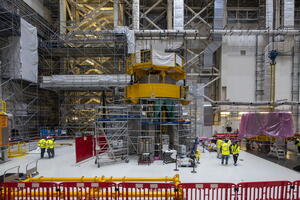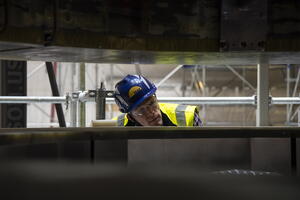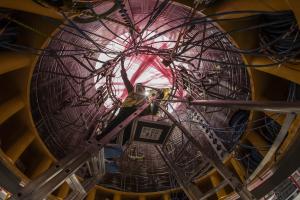First sequences underway
What does it take to assemble the magnet at the heart of ITER? Heavy lifting, unerring accuracy, and a human touch.
The central solenoid will be assembled from six cylindrical modules stacked one on top of the other. Weighing 110 tonnes and standing 2 metres high, each module is massive in its own right. But the modules are not the only heavy objects that will make up the overall structure.
Eighteen metal blocks, each weighing 6 tonnes, will brace the composite magnet from the bottom (9 lower key blocks) and the top (9 upper key blocks). Interior and exterior vertical tie plates will connect the key blocks to form a cage around the central solenoid and compress the modules in operation, adding more than 110 tonnes to the assembly.
The stacking process requires lifting and then accurately positioning these cumbersome objects. The team will use special tools designed and developed by US ITER* as well as highly accurate measurement devices and techniques to align components and make sure the composite magnet is level to within a few millimetres.
Stacking the modules and building the cage
The first module to arrive at ITER was placed on the central solenoid assembly platform in July 2022. The platform, a robust table with nine legs on seismic isolators, was specially designed to bear the mass of the central solenoid magnet and supporting structures.
Several steps were carried out prior to placing the first module. First, hydraulic leveling jacks and laser trackers were used to carefully level the platform. Air gaps were filled with concrete to lock in the level and the platform's legs were anchored into the floor with shear pins.
Then, the nine lower key blocks were attached to the assembly platform to provide a base for the tower. Unlike the assembly platform, the lower key blocks will be transferred inside the ITER machine, where they will continue to act as a foundation for the magnet tower.
Finally, a fibreglass plate was placed on top of the lower key blocks—and the first module now sits on this plate. The layer of fibreglass acts as a low-voltage insulation—keeping the elements of the support structure electrically isolated. But that is not the only purpose of this layer. The thickness of the fibreglass was machined specifically to adjust the total height of the stack.
"We know we'll have to accommodate minor variations in module height, while targeting a specific height of the entire assembly," explains Carl Cormany, superconductor engineer in the Magnet Section. "And that's one of the jobs of this bottom plate. Each module is normally just over two metres tall and four metres in diameter. But for us, a deviation of 20 mm for the entire stack of six will be too much—and you can't predict the deviation until you've made the modules. A module might wind up five millimetres shorter or taller than you thought. Then the stacking process might result in further deviation. The fibreglass plates at the bottom and the top of our stack give us some capacity to adjust."
The first sequence of central solenoid assembly will be to install the three lower modules on top of the key blocks. These lower modules will be attached to their source of power through heavy steel-jacketed busbars (which also supply liquid helium for cooling through specialized joints) before the next three modules are added.
Once all six modules are stacked and joined to their extensions, the upper key blocks will be put on top of the last module, and tie plates—each about 15 metres long—will attach the upper key blocks to the lower key blocks. Eighteen tie plates will be used on the outside and nine on the inside, creating a powerful support cage.
"The cage is needed to hold the magnets together during operational events where the magnets repel one another," explains Cormany. "Sometimes the polarities of the magnets will cause the modules to attract each another. But in other situations—including certain operating scenarios—polarities will be reversed in neighbouring magnets, causing adjacent magnets to repel with tremendous force."
The different elements of the support structure work together to resist this force. "The upper key blocks have five cylinders in them that serve as pistons. We push the cylinders down, smashing the modules together and stretching the tie plates. This provides an enormous compressive force of 210 meganewtons—easily enough to overcome the forces repelling the magnets, which are in the range of 60 meganewtons."
To put these numbers in perspective, United States space shuttles required about 30 meganewtons of thrust on lift off.
Tools for lifting, positioning and drilling
The dedicated tools designed by US ITER include the assembly platform; a lifting device to hoist the modules and stack them on top of one another with millimetre accuracy; a man-lift to allow operations to be performed inside the inner bore of the modules; a drill guide fixture for shear pin holes (shear pins are inserted in these holes to minimize relative motion of modules in the stack during operation); and a variety of alignment fixtures and support structures.
"The module lifting fixture is designed to grasp the module from all sides to lift it," says Cormany. "Nine friction pads spaced around the module exert radial force. It's a little like the way you lift a cup of coffee by cusping your hand around it."
Other tools will be used to make electrical connections and to position the modules precisely. Lasers will establish the exact position of each module relative to the others. If the lasers indicate the module is slightly off target, screws in the laser target mounting brackets can be turned to adjust the position. With the light turn of a screw, a technician will cause the module to move half a millimetre—a reminder that in the end, it will all come together with a human touch.
But for now, the team is at the beginning of the assembly process.
"In the coming months we will be working closely with our TAC-1 assembly contractor to complete the superconducting electrical connections," says Cormany. "This will involve welding, ultrasonic weld inspection, helium leak testing, electrical installation and high voltage testing. Then we will lift the module one more time for a final alignment to the lower key blocks and proceed to install structural shear pins. This is an interesting period for module assembly as it brings together many disciplines and a team of experts from all across the world."
* US ITER is responsible for supplying the central solenoid. This work includes the design, R&D, and fabrication of six coil modules (plus one spare) from superconducting coils supplied by Japan, the associated support structure, assembly tooling, bus extensions, and cooling connections. The ITER Organization is responsible for the assembly of the central solenoid stack in the ITER Assembly Hall.




